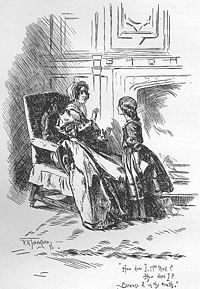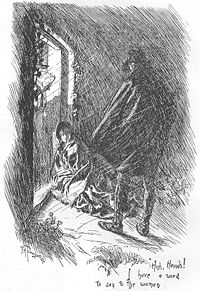The novel is a first-person narrative from the perspective of the title character. The novel's setting is somewhere in the north of England, late in the reign of George III (1760–1820).[a]It goes through five distinct stages: Jane's childhood at Gateshead Hall, where she is emotionally and physically abused by her aunt and cousins; her education at Lowood School, where she gains friends and role models but suffers privations and oppression; her time as governess at Thornfield Hall, where she falls in love with her Byronic employer, Edward Rochester; her time with the Rivers family, during which her earnest but cold clergyman cousin, St. John Rivers, proposes to her; and her reunion with, and marriage to, her beloved Rochester. During these sections, the novel provides perspectives on a number of important social issues and ideas, many of which are critical of the status quo. Literary critic Jerome Beaty opines that the close first person perspective leaves the reader "too uncritically accepting of her worldview", and often leads reading and conversation about the novel towards supporting Jane, regardless of how irregular her ideas or perspectives are.
Jane Eyre is divided into 38 chapters, and most editions are at least 400 pages long. The original publication was in three volumes, comprising chapters 1 to 15, 16 to 27, and 28 to 38; this was a common publishing format during the 19th century (see three-volume novel).
Brontë dedicated the novel's second edition to William Makepeace Thackeray.
Jane's childhood...
The novel begins with the titular character, Jane Eyre, aged 10, living with her maternal uncle's family, the Reeds, as a result of her uncle's dying wish. It is several years after her parents died of typhus. Mr. Reed, Jane's uncle, was the only person in the Reed family who was ever kind to Jane. Jane's aunt, Sarah Reed, dislikes her, treats her as a burden, and discourages her children from associating with Jane. Mrs. Reed and her three children are abusive to Jane, physically, emotionally, and spiritually. The nursemaid Bessie proves to be Jane's only ally in the household, even though Bessie sometimes harshly scolds Jane. Excluded from the family activities, Jane is incredibly unhappy, with only a doll and books for comfort.
One day, after her cousin John Reed knocks her down and she attempts to defend herself, Jane is locked in the red room where her uncle died; there, she faints from panic after she thinks she has seen his ghost. She is subsequently attended to by the kindly apothecary Mr. Lloyd to whom Jane reveals how unhappy she is living at Gateshead Hall. He recommends to Mrs. Reed that Jane should be sent to school, an idea Mrs. Reed happily supports. Mrs. Reed then enlists the aid of the harsh Mr. Brocklehurst, director of Lowood Institution, a charity school for girls. Mrs. Reed cautions Mr. Brocklehurst that Jane has a "tendency for deceit", which he interprets as her being a "liar". Before Jane leaves, however, she confronts Mrs. Reed and declares that she'll never call her "aunt" again, that Mrs. Reed and her daughters, Georgiana and Eliza, are the ones who are deceitful, and that she will tell everyone at Lowood how cruelly Mrs. Reed treated her.
Lowood...
At Lowood Institution, a school for poor and orphaned girls, Jane soon finds that life is harsh, but she attempts to fit in and befriends an older girl, Helen Burns, who is able to accept her punishment philosophically. During a school inspection by Mr. Brocklehurst, Jane accidentally breaks her slate, thereby drawing attention to herself. He then stands her on a stool, brands her a liar, and shames her before the entire assembly. Jane is later comforted by her friend, Helen. Miss Temple, the caring superintendent, facilitates Jane's self-defence and writes to Mr. Lloyd, whose reply agrees with Jane's. Jane is then publicly cleared of Mr. Brocklehurst's accusations.
The 80 pupils at Lowood are subjected to cold rooms, poor meals, and thin clothing. Many students fall ill when a typhus epidemic strikes, and Jane's friend Helen dies of consumption in her arms. When Mr. Brocklehurst's maltreatment of the students is discovered, several benefactors erect a new building and install a sympathetic management committee to moderate Mr. Brocklehurst's harsh rule. Conditions at the school then improve dramatically.
The name Lowood symbolizes the "low" point in Jane's life where she was maltreated. Helen Burns is a representation of Charlotte's elder sister Maria, who died of tuberculosis after spending time at a school where the children were mistreated.
Thornfield Hall...
After six years as a student and two as a teacher at Lowood, Jane decides to leave, like her friend and confidante Miss Temple, who recently married. She advertises her services as a governess and receives one reply, from Alice Fairfax, housekeeper at Thornfield Hall. Jane takes the position, teaching Adèle Varens, a young French girl.
One night, while Jane is walking to a nearby town, a horseman passes her. The horse slips on ice and throws the rider. Despite the rider's surliness, Jane helps him to get back onto his horse. Later, back at Thornfield, she learns that this man is Edward Rochester, master of the house. Adèle is his ward, left in his care when her mother abandoned her.
At Jane's first meeting with him within Thornfield, Mr. Rochester teases her, accusing her of bewitching his horse to make him fall. He also talks strangely in other ways, but Jane is able to stand up to his initially arrogant manner. Mr. Rochester and Jane soon come to enjoy each other's company, and spend many evenings together.
Odd things start to happen at the house, such as a strange laugh, a mysterious fire in Mr. Rochester's room (from which Jane saves Rochester by rousing him and throwing water on him and the fire), and an attack on a house guest named Mr. Mason. Then Jane receives word that her aunt Mrs. Reed is calling for her, because she suffered a stroke after her son John died. Jane returns to Gateshead and remains there for a month, attending to her dying aunt. Mrs. Reed confesses to Jane that she wronged her, giving Jane a letter from Jane's paternal uncle, Mr. John Eyre, in which he asks for her to live with him and be his heir. Mrs. Reed admits to telling Mr. Eyre that Jane had died of fever at Lowood. Soon afterward, Mrs. Reed dies, and Jane helps her cousins after the funeral before returning to Thornfield.
Back at Thornfield, Jane broods over Mr. Rochester's rumoured impending marriage to the beautiful and talented, but snobbish and heartless, Blanche Ingram. However, one midsummer evening, Rochester baits Jane by saying how much he will miss her after getting married, but how she will soon forget him. The normally self-controlled Jane reveals her feelings for him. Rochester is then sure that Jane is sincerely in love with him, and he proposes marriage. Jane is at first sceptical of his sincerity, but eventually believes him and gladly agrees to marry him. She then writes to her Uncle John, telling him of her happy news.
As she prepares for her wedding, Jane's forebodings arise when a strange woman sneaks into her room one night and rips her wedding veil in two. As with the previous mysterious events, Mr. Rochester attributes the incident to Grace Poole, one of his servants. During the wedding ceremony, Mr. Mason and a lawyer declare that Mr. Rochester cannot marry because he is already married to Mr. Mason's sister, Bertha. Mr. Rochester admits this is true but explains that his father tricked him into the marriage for her money. Once they were united, he discovered that she was rapidly descending into congenital madness, and so he eventually locked her away in Thornfield, hiring Grace Poole as a nurse to look after her. When Grace gets drunk, Rochester's wife escapes and causes the strange happenings at Thornfield.
It turns out that Jane's uncle, Mr. John Eyre, is a friend of Mr. Mason's and was visited by him soon after Mr. Eyre received Jane's letter about her impending marriage. After the marriage ceremony is broken off, Mr. Rochester asks Jane to go with him to the south of France, and live with him as husband and wife, even though they cannot be married. Refusing to go against her principles, and despite her love for him, Jane leaves Thornfield in the middle of the night.
Other employment...
Jane travels as far from Thornfield as she can using the little money she had previously saved. She accidentally leaves her bundle of possessions on the coach and has to sleep on the moor, and unsuccessfully attempts to trade her handkerchief and gloves for food. Exhausted and hungry, she eventually makes her way to the home of Diana and Mary Rivers, but is turned away by the housekeeper. She collapses on the doorstep, preparing for her death. St. John Rivers, Diana and Mary's brother and a clergyman, saves her. After she regains her health, St. John finds Jane a teaching position at a nearby village school. Jane becomes good friends with the sisters, but St. John remains aloof.
The sisters leave for governess jobs, and St. John becomes somewhat closer to Jane. St. John learns Jane's true identity and astounds her by telling her that her uncle, John Eyre, has died and left her his entire fortune of 20,000 pounds (equivalent to over £1.3 million in 2011. When Jane questions him further, St. John reveals that John Eyre is also his and his sisters' uncle. They had once hoped for a share of the inheritance but were left virtually nothing. Jane, overjoyed by finding that she has living and friendly family members, insists on sharing the money equally with her cousins, and Diana and Mary come back to live at Moor House.
Proposals...
Thinking Jane will make a suitable missionary's wife, St. John asks her to marry him and to go with him to India, not out of love, but out of duty. Jane initially accepts going to India but rejects the marriage proposal, suggesting they travel as brother and sister. As soon as Jane's resolve against marriage to St. John begins to weaken, she mystically hears Mr. Rochester's voice calling her name. Jane then returns to Thornfield to find only blackened ruins. She learns that Mr. Rochester's wife set the house on fire and committed suicide by jumping from the roof. In his rescue attempts, Mr. Rochester lost a hand and his eyesight. Jane reunites with him, but he fears that she will be repulsed by his condition. "Am I hideous, Jane?", he asks. "Very, sir: you always were, you know", she replies. When Jane assures him of her love and tells him that she will never leave him, Mr. Rochester again proposes, and they are married. He eventually recovers enough sight to see their firstborn son.





No comments:
Post a Comment